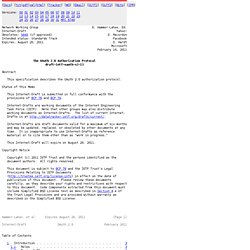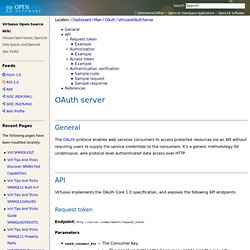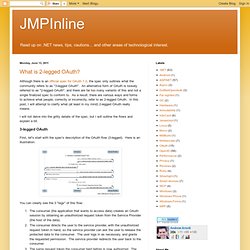

Ietf-oauth-v2-13 - The OAuth 2.0 Authorization Protocol. [Docs] [txt|pdf|xml|html] [Tracker] [WG] [Email] [Diff1] [Diff2] [Nits] [IPR] Versions: 00 01 02 03 04 05 06 07 08 09 10 11 12 13 14 15 16 17 18 19 20 21 22 23 24 25 26 27 28 29 30 31 RFC 6749 Network Working Group E.

Hammer-Lahav, Ed. Internet-Draft Yahoo! Obsoletes: 5849 (if approved) D. Recordon Intended status: Standards Track Facebook Expires: August 20, 2011 D. Internet-Draft OAuth 2.0 February 2011 Table of Contents 1. Internet-Draft OAuth 2.0 February 2011 1. In the traditional client-server authentication model, the client accesses a protected resource on the server by authenticating with the server using the resource owner's credentials. 1.1. OAuth includes four roles working together to grant and provide access to protected resources - access restricted resources which Hammer-Lahav, et al. Marc Worrell/ OAuth Server And Consumer in PHP. Here is the full implementation of OAuth for anyMeta.

For now we publish this as a direct export from our svn repository. It includes full server and client code, including database tables for the storage of tokens and consumer keys. It also includes optional request logging and smarty templates. It has been tested with PHP 5.2. The code is released under the GPL v2. Files The repository contains the following files: OAuth.mod.php This is the anyMeta module.
Templates/ This directory contains the templates we use. Test/ Contains a simple test script. Core/ OAuth server. General The OAuth protocol enables web services consumers to access protected resources via an API without requiring users to supply the service credentials to the consumers.

It's a generic methodology for unobtrusive, wire protocol level authenticated data access over HTTP. Virtuoso implements the OAuth Core 1.0 specification, and exposes the following API endpoints: Request token Endpoint: Parameters oauth_consumer_key — The Consumer Key. Example Request: =dad4cb071e2169cbcaa051d404ac61a3&oauth_timestamp=1201873644&oauth_cons umer_key=f756023be5ff1f20881cf8fe398069f3976b2304&oauth_signature_metho d=HMAC-SHA1&oauth_signature=z76k5fQ0msFsQzCmhO%2FJZ329ZUE%3D Note: all long lines in example texts are split, i.e., the GET request is single line.
Selead/oauth-server - GitHub. JMPInline: What is 2-legged OAuth? Although there is an official spec for OAuth 1.0, the spec only outlines what the community refers to as "3-legged OAuth".

An alternative form of OAuth is loosely referred to as "2-legged OAuth", and there are far too many variants of this and not a single finalized spec to conform to. As a result, there are various ways and forms to achieve what people, correctly or incorrectly, refer to as 2-legged OAuth. In this post, I will attempt to clarify what (at least in my mind) 2-legged OAuth really means. I will not delve into the gritty details of the spec, but I will outline the flows and explain a bit. OAuth Test Server. Server | client OAuth Test Server Instructions for Use This is a test server with a predefined static set of keys and tokens, you can make your requests using them to test your code (and mine ;)). Your Consumer Key / Secret consumer key: keyconsumer secret: secret Use this key and secret for all your requests. Getting a Request Token request token endpoint: A successful request will return the following: oauth_token=requestkey&oauth_token_secret=requestsecret An unsuccessful request will attempt to describe what went wrong.
Example Getting an Access Token The Request Token provided above is already authorized, you may use it to request an Access Token right away. access token endpoint: oauth_token=accesskey&oauth_token_secret=accesssecret Making Authenticated Calls Using your Access Token you can make authenticated calls. api endpoint: A successful request will echo the non-OAuth parameters sent to it, for example: method=foo&bar=baz Currently Supported Signature Methods Current signing method is: